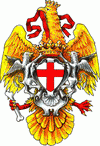Caltagirone
 |
The town is a production center of pottery, particularly maiolica and terra-cotta wares. Nowadays, the production is more and more oriented to artistic production of ceramics and terra-cotta sculptures. Other activities are mainly related to agriculture (production of grapes, olives, peaches), third-sector activities and tourism.
The city's name derives from the Arabic qalʿat al-jirār (قلعة الجرار, "castle of [pottery] jars") – a name that attests to the antiquity of the pottery works which are still thriving. It has been inhabited since prehistoric times, as shown by the presence of two necropoleis dating from the second millennium BCE and by numerous other archaeological finds. It was later inhabited by the Sicels pre-Roman population.
The Arabs built a castle here that in 1030 was attacked by Ligurian troops under the Byzantine general George Maniakes, who have left traces of Ligurian language in the current dialect. The city flourished under the Norman and Hohenstaufen domination, becoming a renowned center for production of ceramics.
The city was almost completely destroyed by the earthquake of 1693. Many public and private buildings were then reconstructed in a Sicilian Baroque style. Primarily for this reason the city has been included, together with the surrounding territory, in an area protected by the UNESCO World Heritage program.
In May 29, 1860, the town was looted by the Bourbon army led by general Gaetano Afan de Rivera, while fleeing from the Garibaldini forces towards Catania.
During the first part of the XX Century, it was the house of Italian Christian democracy, due to the presence of renowned politician Luigi Sturzo. Later, the town expressed various nationwide politician, such as Italian Prime minister Mario Scelba, and Sicilian president Silvio Milazzo.
Today, Caltagirone is a mid-tier Sicilian town. It is one of the 25 most populous town in Sicily, and one of the 250 most populous in Italy.
Map - Caltagirone
Map
Country - Italy
 |
 |
| Flag of Italy | |
Italy was the native place of many civilizations such as the Italic peoples and the Etruscans, while due to its central geographic location in Southern Europe and the Mediterranean, the country has also historically been home to myriad peoples and cultures, who immigrated to the peninsula throughout history. The Latins, native of central Italy, formed the Roman Kingdom in the 8th century BC, which eventually became a republic with a government of the Senate and the People. The Roman Republic initially conquered and assimilated its neighbours on the Italian peninsula, eventually expanding and conquering a large part of Europe, North Africa and Western Asia. By the first century BC, the Roman Empire emerged as the dominant power in the Mediterranean Basin and became a leading cultural, political and religious centre, inaugurating the Pax Romana, a period of more than 200 years during which Italy's law, technology, economy, art, and literature developed.
Currency / Language
| ISO | Currency | Symbol | Significant figures |
|---|---|---|---|
| EUR | Euro | € | 2 |
| ISO | Language |
|---|---|
| CA | Catalan language |
| CO | Corsican language |
| FR | French language |
| DE | German language |
| IT | Italian language |
| SC | Sardinian language |
| SL | Slovene language |















